AIR 16 Feature: Quinci Baker
Ciara McNamara, Artist Programs intern at TAC, got together with current AIR 16 resident Quinci Baker:
Ciara: Hi Quinci, I am excited to talk to you about your art and upcoming projects! Your work is a unique combination of many different materials carefully crafted into works on wood, colorful beaded sculptures, and experimental pieces incorporating materials like steel and synthetic hair. How do you choose what materials to use for your artworks?
Quinci: My process of bringing certain materials into my studio is based on personal and cultural memories. I bring materials together that are central to my identity in some way. They can trigger a memory or sometimes reflect images that have influenced me as a person. So all of my source material is pulled from different experiences.
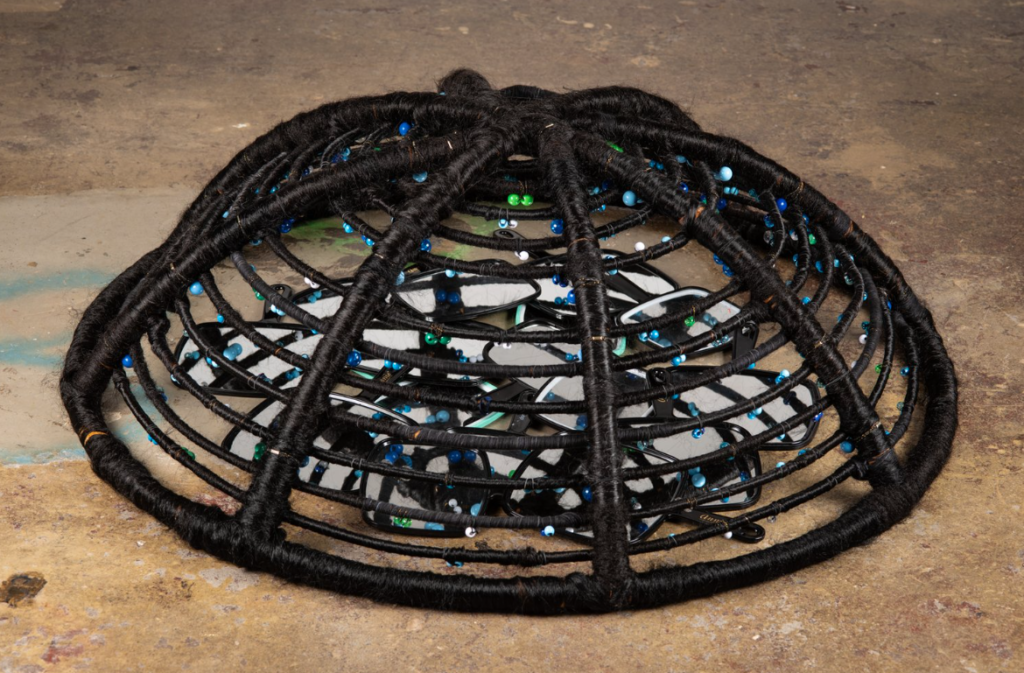
Ciara: How do you decide what materials to use and where do you find those materials?
Quinci: Some materials I source directly, some are second-hand, and others are donated by my family. I am usually the first person my family will contact with items they are looking to donate. The quotidian is important for me in my practice, so I always invite that into my space.
Ciara: You have spoken about your work existing to represent, in part, the mnemonics of cultural identity and the erasure of personal and collective histories. Could you tell me more about how these themes are present in your work?
Quinci: Sure. Those themes encompass a lot of what my overall practice is, and memory is a huge conduit for my aspirations. I use a lot of family photos and colors or patterns that remind me of my childhood, as well as footage of historical events. I think about childhood as a great place for exploration. My memory is very sensory, so there are certain more nameable influences for me and some that are more abstract. I try to combine these influences and utilize the context of who I am today, while still thinking of that openness and connection that is more intuitive than intentional.
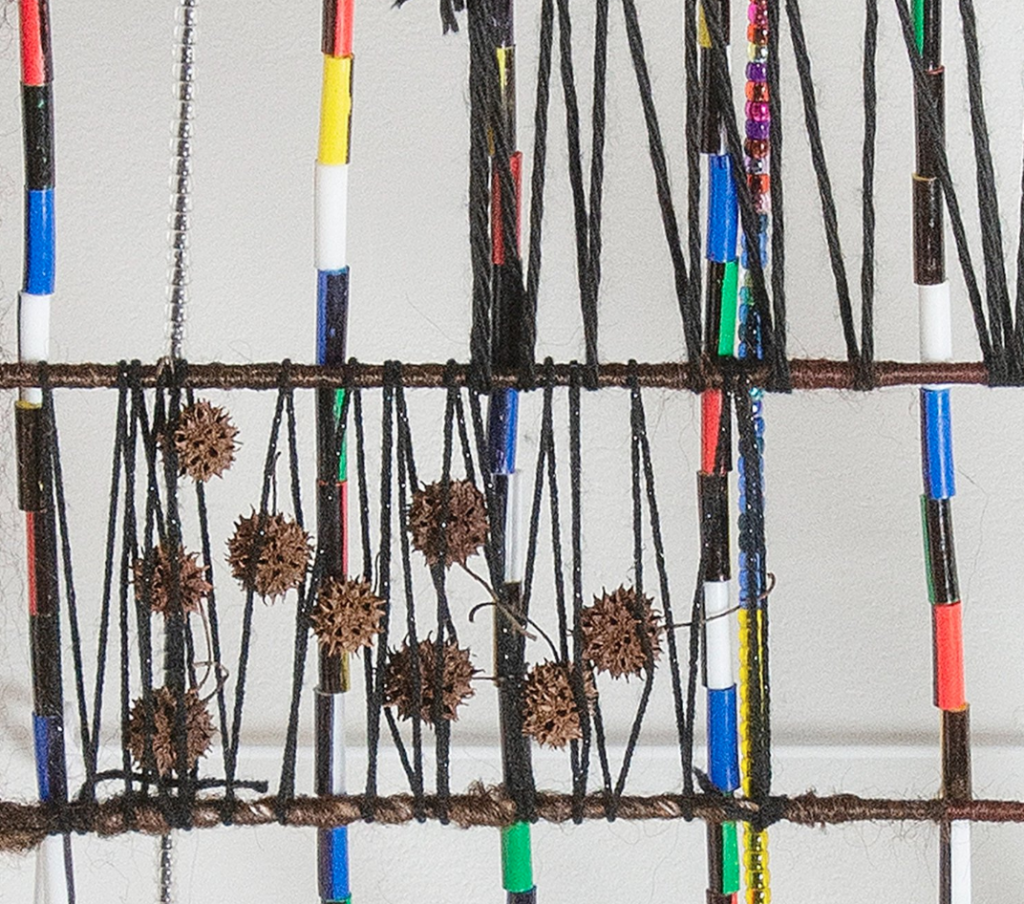
Ciara: Could you talk more about the intuitive, more play-based aspects? You incorporate so many different colors and patterns into your work, in what ways do those choices have to do with your childhood or collective histories?
Quinci: I would say for the color schemes I choose a lot of predetermined sets of color, things like hair accessories or crayons. They are formative for creative exploration, having a set of colors that you are working from.
Ciara: And how do you think your work has evolved through your medium?
Quinci: I love that question. Material is a huge conduit for my inspiration. I bring materials into my practice based on their history and my connection to them, or sometimes with an ease with which I can have a conversation, whether it is the memory or a colorful, easy item to respond to. Working with found objects, for example, they have a very clear history. I try to let those materials inform me and we end up having a flowing dialogue where I am honoring the materials and listening.
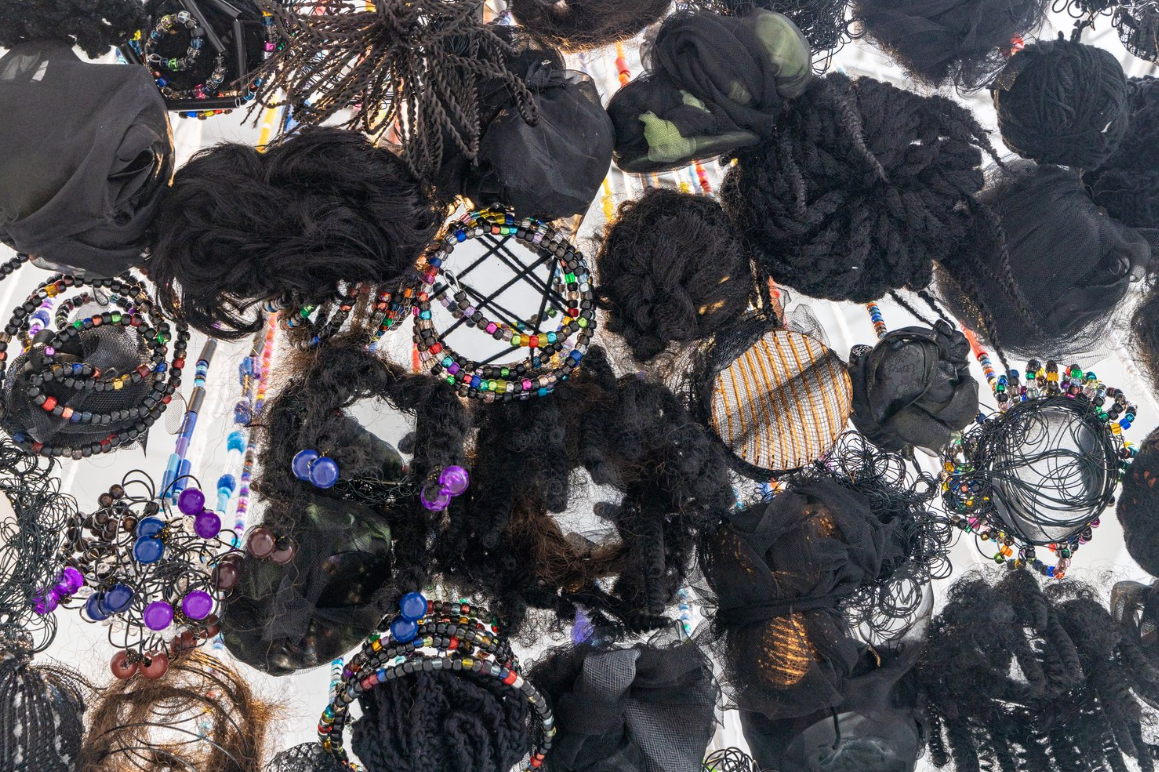
Ciara: Keeping your relationship with material and play in mind, could you talk to me about the tall spiral sculpture behind you?
Quinci: Sure, it is untitled currently. Something that I wanted to consider in making this sculpture was DNA and the data that lives inside us, in our bodies. I am inspired by how the idea of data, with the spiral at the top of the sculpture, connects to spirituality and more specifically connecting with our ancestors, allowing a directional realm.
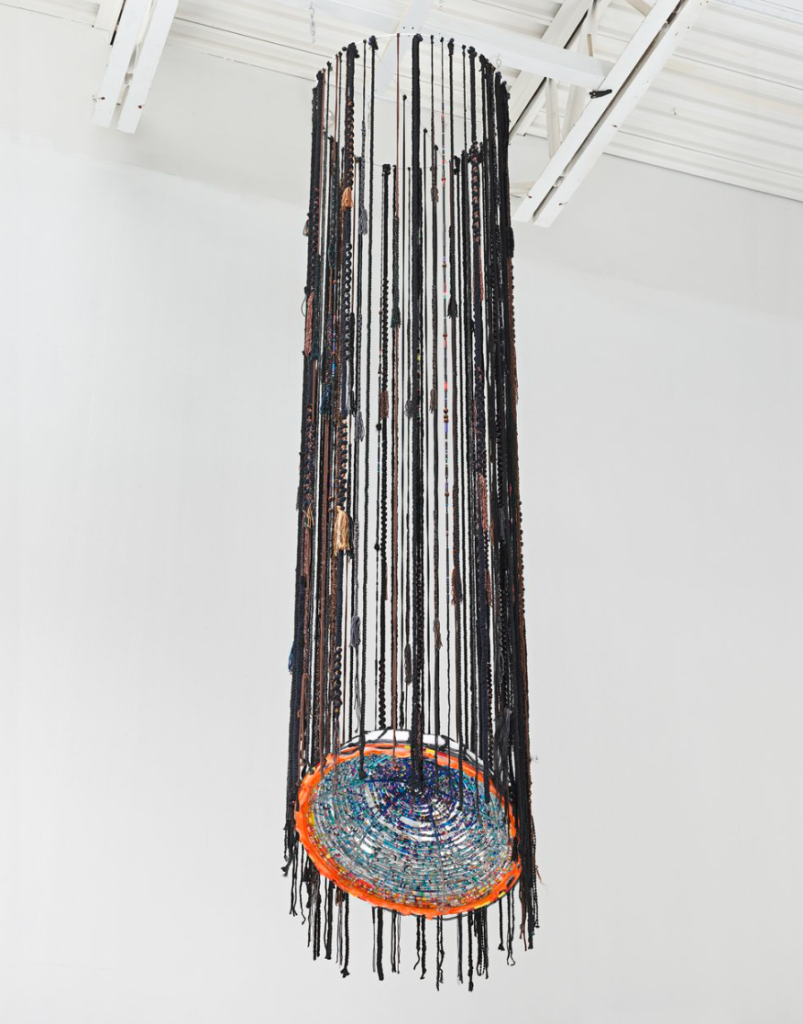
I am also considering the confirmed reality of what lives inside of us, and all of these elements are connected very poetically. The spiral also draws me to thinking of a fingerprint, or all different things occurring in nature with spirals that mimic each other. So the spiral is really its own school of thought, its own universe, visually speaking.
Ciara: That is so fascinating. How do the material choices of different beads, wool/ yarn, and synthetic hair inform the sculpture and this idea of DNA and the spiralled school of thought?
Quinci: Firstly, using hair is an essential part of my work as a medium since hair as an artistic practice is largely unrecognized. It is for that reason that I really enjoy using hair as a medium. When I first began investigating using synthetic hair as a medium I felt stuck in a rut in my thinking process. I was doing my hair a lot with my sister and best friend, we would braid each other's hair.
I just thought of how sculptural and community-based the whole idea of doing hair together is and what it really meant. How beautifully aesthetic it was… so hair became part of my practice, and as I went further and further into that material being central to my work, I began to realize the level of artistry that existed atop people’s heads and how formative of a sculptural medium hair is to different societies. As a black woman, this artistic medium is informative, it’s an archive and I revere the material a lot. It is something I really enjoy using as a jumping off point, materially and conceptually.
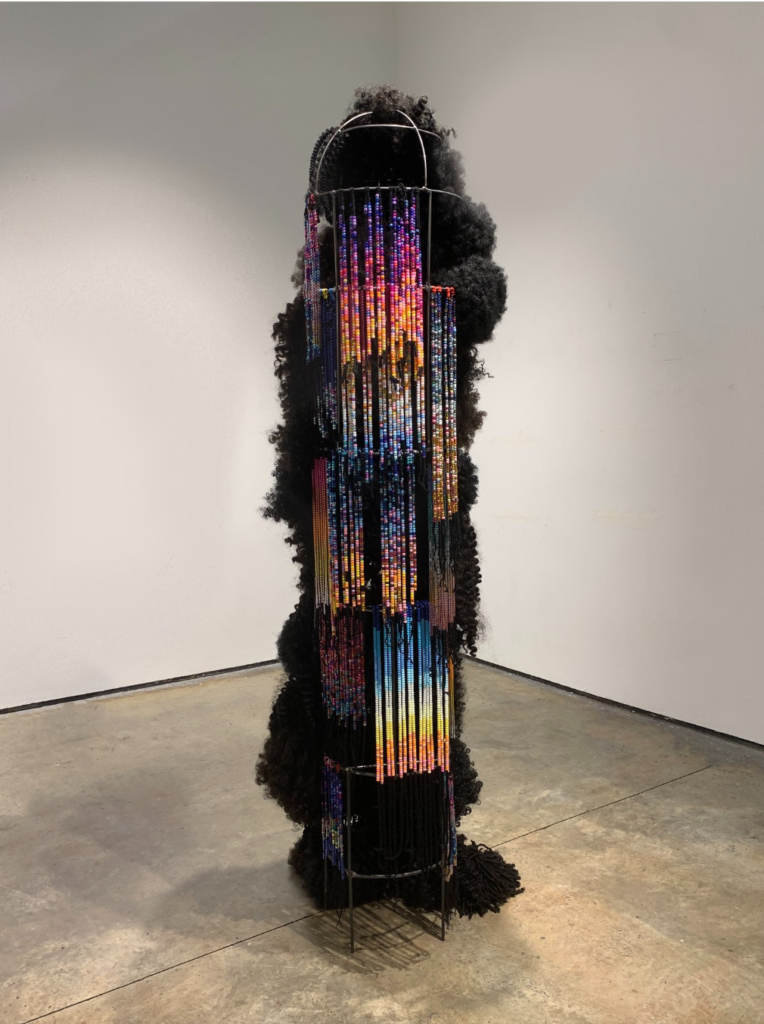
The pony beads [there are many pony beads lining each ‘strand’ in the sculpture] make me think through memories of my childhood. I used to wear beads on my hair and get my hair cornrowed in the summer. I have the memory of hearing the beads as I walk, and feeling them. I knew that bringing together these materials within my studio would ignite some type of creative spark in me. They represent a personal material that I have worn on my head, and that many, many people who look like me, black femmes of my generation, have also worn. There is such a rich history with beading and so many cultures globally have their own relationship with beads. It is really an amazing material for us to think about.
Ciara: Did you always know that you wanted to be an artist?
Quinci: I didn't, actually. I was always very creative, but I loved math and history growing up too. When I was applying to colleges, I began to embrace the idea of art school. I went to a high school with a magnet program in the arts and loved my art courses. A big source of inspiration for me ultimately becoming an artist was that earlier arts education and being encouraged to explore my creativity more. When other people see something in you, sometimes you think, maybe I should pursue this further. When I graduated college, I still kept a studio, but I was not really thinking of becoming an artist as a career path. Eventually, it became the only option for me, when I realized I couldn't be happy doing anything else.
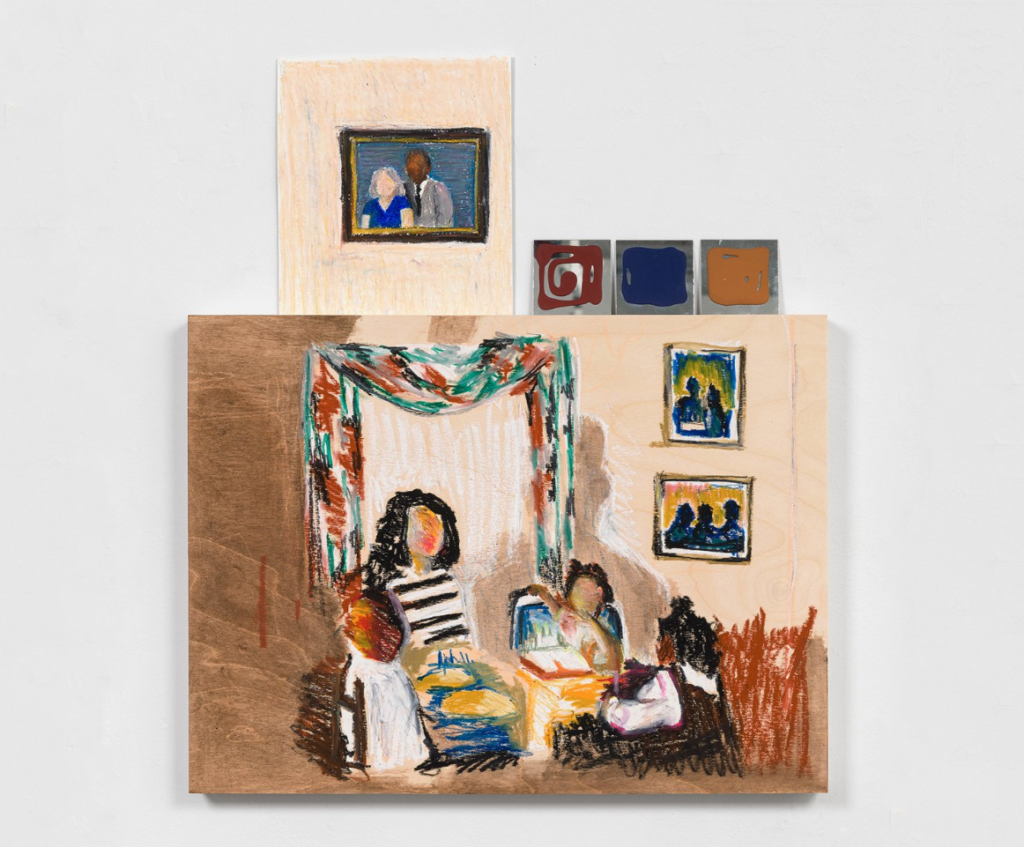
Ciara: Why is your art practice important to you?
Quinci: My art practice is what grounds me. It is a spiritual practice for me personally. I think art is what makes us human. It is one of the most formative, defining characteristics of humanity and is an important means for connection to one another and the universe around us. We all need a way to process, and art is the most tangible way I can understand and center myself.
Ciara: I totally agree with you in the grounding and centering of making art. That also lends to my next question which is why you think it is important for others to make art.
Quinci: Yeah, there is something for everyone to engage in the arts in whatever way that manifests for you. I think if everyone had a creative outlet, we as a society would be a much more empathetic place with more connection to one another.
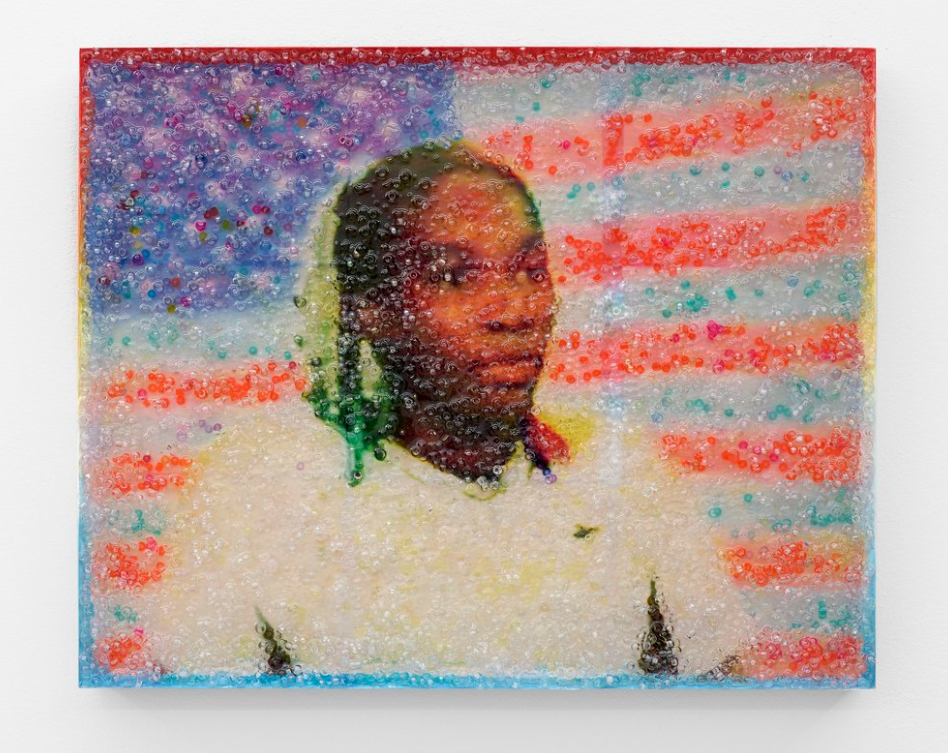
Ciara: Yes, completely. Unfortunately we are not quite there… or close to that point.
Quinci: Yeah, definitely a bit of a delay currently…
Ciara: You spoke with me yesterday about an upcoming show, could you talk to me more about that?
Quinci: Sure. I have an upcoming exhibition titled, In the Cut, at A.I.R. Gallery that is opening at the end of April, on the 26th. If all goes well, the pieces in my studio here will be in the show, in addition to others. The exhibition is an installation inspired by the concept of desire paths, which are typically defined as these pathways that form, in spite of a designated path. For example, if there’s a courtyard with a sidewalk or pathway that goes along the perimeter of the square but people instead choose to cut across the grass, slowly but surely, a foot trail appears. Most commonly a desire path is a foot trail, deer trail, or something that cuts through other things.
I thought of the desire path as a jumping off point for this exhibition because I think that our society kind of puts you in a lane and any time that you deter from that lane, you’re kind of forging your own path. The more that these paths appear, the more people diverge, until there is a type of solidarity formed by the creation of these pathways. Sometimes you may not even realize you are on a desire path until you turn into one of the people who are laying that groundwork down.
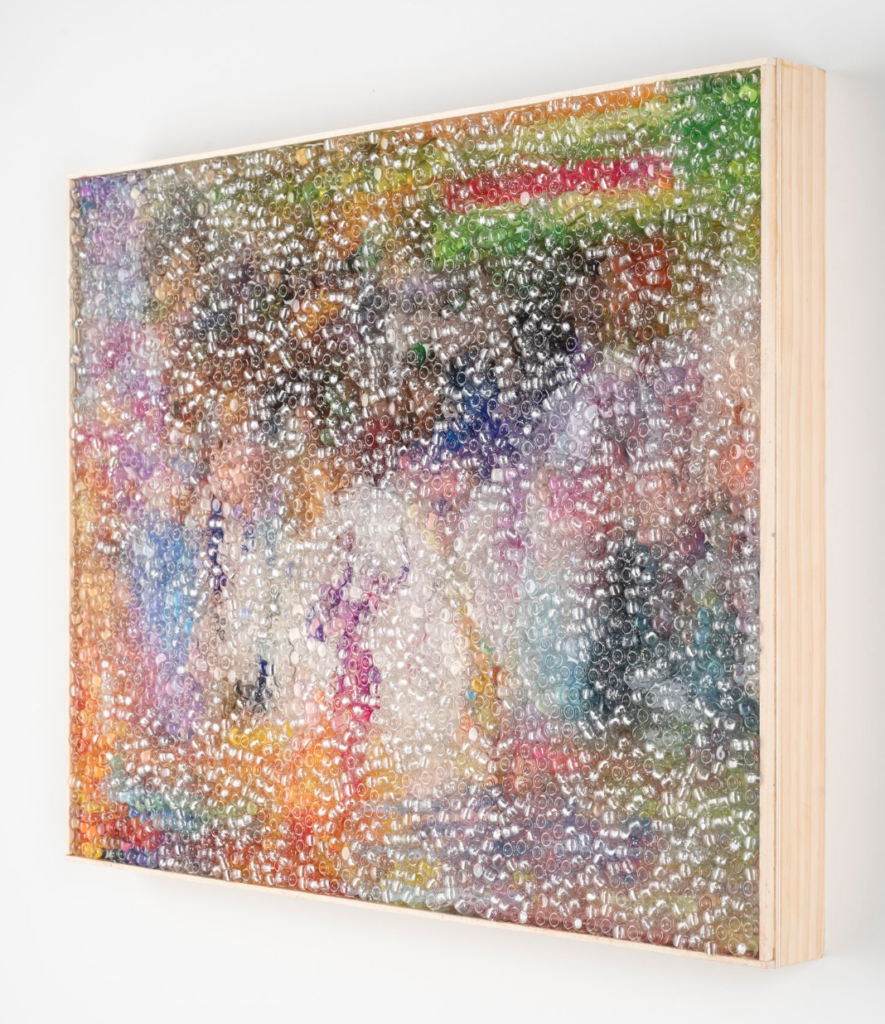
Ciara: Have desire paths always been an interest of yours, or is it more of a recent conceptual discovery?
Quinci: I have always been very interested in them since they are everywhere, especially in cities. For the past 10 or so years they have been on my mind. For this exhibition, I just thought that visually it was a beautiful concept and could be applied to so many aspects of life. When I first learned about them, I thought about the first maroon societies formed throughout the African diaspora in the Americas. A lot of these maroon societies, especially the first ones, were able to form because people learned the environment around them. They were able to hide in plain sight, within interiors, mountains, swamps— very aggressive climates by learning and becoming in tune with those environments in ways that colonizers were never able to.
When thinking of desire paths and something slowly forming, there are these alternative universes happening at once. Taking into account the African diaspora and our history with colonialism, the connection was very clear to me for a long time, so it was more about finding the time to engage with that conversation. It has been a long time coming.
Ciara: Shifting gears a bit, how did you find the Textile Arts Center, and why did you want to pursue a residency here?
Quinci: I found out about the Textile Arts Center through word of mouth. I know some people that have taken courses here and some artists who have done the residency here. Seeing TAC through their perspectives was really my introduction. A lot of my work engages with textile, but I have definitely come into it from a different angle. I have a history of textile arts in my family; my grandmother was a quilter who passed away before I could learn any of those skills from her directly. My mother who also passed away was very crafty as well and a talented seamstress. My grandfather was a carpenter too, so I feel like the conversation of craft and textile runs through me, but I do not necessarily have the skills. So this residency was kind of a full circle moment to be able to learn the crafts that my family knows.
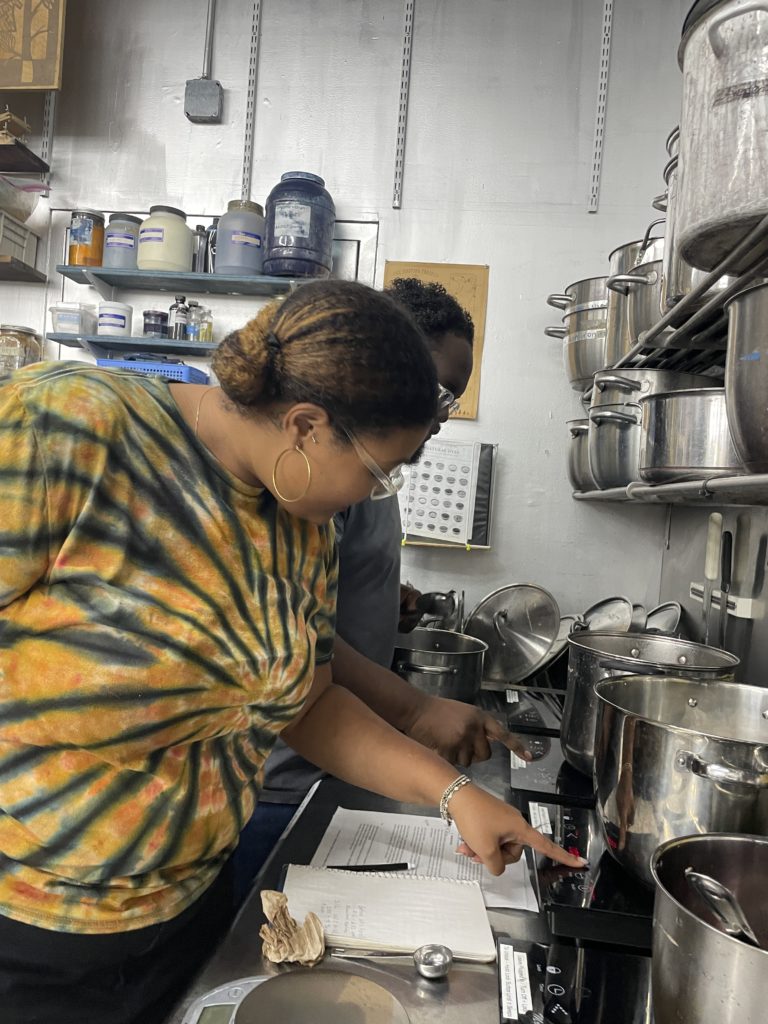
I had been making quilts essentially, without actually quilting, since I didn’t know how to sew, so now that I have learned, I am looking forward to figuring out how to combine everything together. [Quinci points to her ‘quilt without quilting’ which has umber colored, crocheted granny squares with lime green hair knockers and wooden dowels forming a quilt-like formation.]
Ciara: What ideas are you currently working through in terms of what you have done during your residency at the Textile Arts Center and what you might want to apply to your final project that will be exhibited in September?
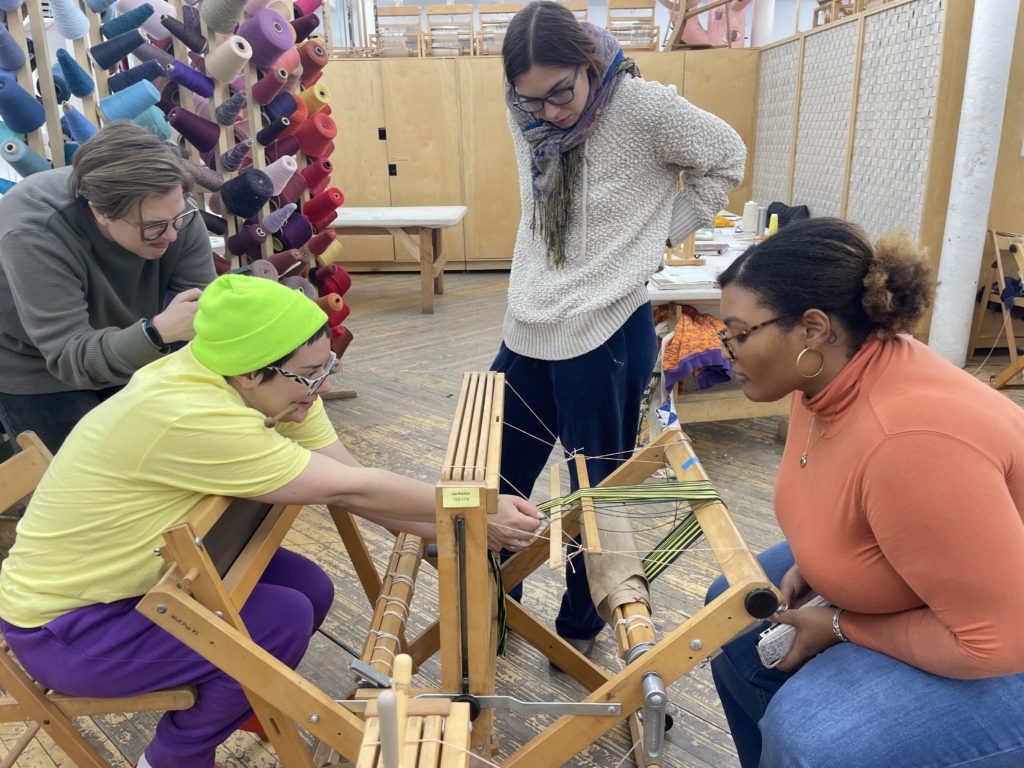
Quinci: I definitely want to engage with quilting for my final project. I also took a vessel making workshop with Faviola [fellow AIR 16 artist] where we created coils using corn husks. It brought me to thinking of Senegalese twists which is how I often style my hair and the practice of coiling vessels as very similar. Senegalese baskets as well, although I have never made them before and I would really like to investigate the direct relationship between twisting hair and creation of textile vessels.
Ciara: Well I am very excited to see where that will take you. And in the meantime, good luck preparing for your Exhibition, In the Cut, opening April 26th at A.I.R. Gallery! In The Cut Exhibition Info! [Exhibition is open until May 25th!]
Quinci Baker is a mixed-media artist from Prince George’s County, Maryland. Her works blend personal and cultural archives with various craft and repurposed materials in an exploration of collective memory, loss, and imagination.
Baker earned her MFA in Painting and Printmaking from the Yale School of Art in 2022 and her BFA from The Cooper Union School of Art in 2017. Her work has been exhibited at The Hole, NYC; Jeffrey Deitch Gallery in NYC; Jenkins Johnson Projects in Brooklyn, NY; Mehari Sequar Gallery in Washington, DC; and Keijsers Koning in Dallas, TX. Notable residencies include Shandaken: Storm King in New Windsor, NY, and SOMA Summer in San Rafael, Mexico. Baker was recently named the 2024 Emma Bernstein Fellow at A.I.R. Gallery in Brooklyn, NY. She lives and works in NYC.
About the AIR program:
TAC AIR combines studio access with a rigorous interdisciplinary curriculum, and regular critical dialogue, providing residents an opportunity to learn and explore the textile medium, and an alternative to traditional higher education programs. The residency culminates in a group exhibition produced and hosted by TAC. Since 2010, TAC AIR has graduated over 100 artists and designers whose work continues to further textile art within the fashion, fine arts, design and art education fields.